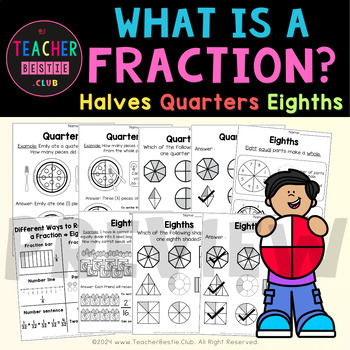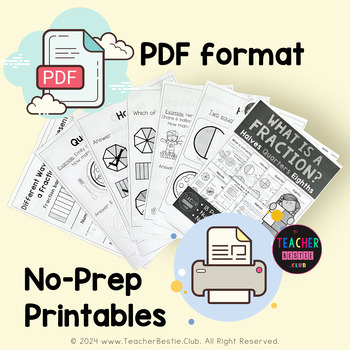What is a Fraction? Halves Quarters Eighths | 3rd Grade Fraction Review. No Prep
- PDF
Description
⭐ What is a Fraction? Halves Quarters Eighths | 3rd Grade Fraction Review, No Prep
- 18 Pages of Easy Fraction Review with Examples.
- Understanding What's Numerator/Denominator?
- 6 Different Ways to Represent a Fraction (Halves, Quarters and Eighths).
- No-Prep Printables
- PDF Format
✅These Resources are perfect for
Introducing mini lessons of fractions and help with understanding fractions in your math lessons. It introduces the basics of halves, quarters and eighths of a fraction.
.
✅ Colors : Colors may vary slightly from appearance on computer screen to printed files. Each monitor displays colors slightly different. Color intensity and variation in the printed format will depend on printer quality, printing settings, paper texture and quality.
.
You May Also Line My Other Resources :
⭐ Freebie Tracing Letters and Print Worksheets | Alphabet Handwriting Practice | No Prep
⭐ Sight Word Practice | Sight Word Builder | 162 Sight Words Flash Cards Printable
⭐ All About Me | All About Me Worksheet | All About Me Writing | US & UK Versions
⭐ Editable Name Tags in PowerPoint | A Frog In My Garden | Classroom Decor 3 Sizes | Colors B&W
⭐ Printable 100 Chart | Missing numbers Worksheets | Missing Numbers | 1-100 Worksheets
⭐ What is a Fraction? Halves Quarters Eighths | 3rd Grade Fraction Review, No Prep
.
⏰ Delivery Time:
• Instant Download
• After the order is placed you will be able to instantly download the file
• Download the resource later in TPT account under 'My Purchases'
.
Refund Policy:
• Refunds are not accepted for digital files
.
Every page of this resource is the Copyrighted property of
© 2024 www.TeacherBestie.Club. All Right Reserved.
.
If you have any questions, comments, concerns,
Please don't hesitate to contact me
⭐ at teacherbestieclub@gmail.com
I'll reply you as soon as I could within 24 hrs.
And If you are happy with my resource and want to be
the 1st to get the Latest Resource Notifications, Sale Info,
please follow me and consider leaving feedback for my store :)
⭐ https://www.teacherspayteachers.com/Store/Teacher-Bestie-Club
.
Have A Nice Day!!!
Ploykhanabune R.
.
Terms Of Use.
• You are granted permission to use this product for your personal or single classroom use only.
• You are Permitted to share this resource with your students online through a secure, password protected site only. Online sharing in any other form is strictly forbidden and is a violation of the Digital Millennium Copyright Act (DMCA).
• Duplication for an entire school system or commercial purposes is strictly forbidden without written permission from the author.
• You may not create a derivative work and claim it as your own.
• You may not sell, trade, share or redistribute this product to any form.
⭐ Copyright © 2024 www.TeacherBestie.Club. All Right Reserved.





